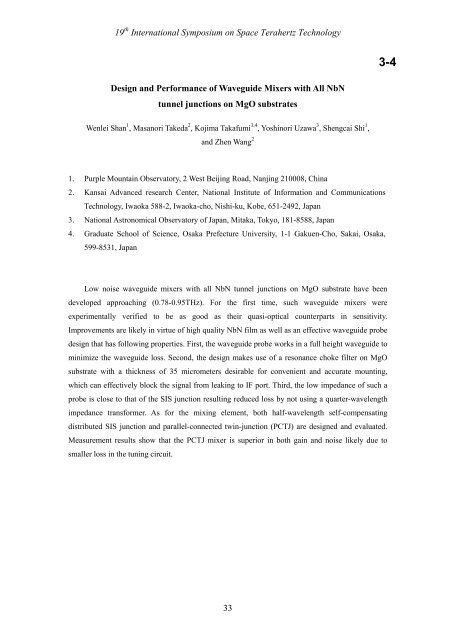Program and Abstract Book - SRON
Program and Abstract Book - SRON
Program and Abstract Book - SRON
Create successful ePaper yourself
Turn your PDF publications into a flip-book with our unique Google optimized e-Paper software.
19 th International Symposium on Space Terahertz Technology<br />
3-4<br />
Design <strong>and</strong> Performance of Waveguide Mixers with All NbN<br />
tunnel junctions on MgO substrates<br />
Wenlei Shan 1 , Masanori Takeda 2 , Kojima Takafumi 3,4 , Yoshinori Uzawa 3 , Shengcai Shi 1 ,<br />
<strong>and</strong> Zhen Wang 2<br />
1. Purple Mountain Observatory, 2 West Beijing Road, Nanjing 210008, China<br />
2. Kansai Advanced research Center, National Institute of Information <strong>and</strong> Communications<br />
Technology, Iwaoka 588-2, Iwaoka-cho, Nishi-ku, Kobe, 651-2492, Japan<br />
3. National Astronomical Observatory of Japan, Mitaka, Tokyo, 181-8588, Japan<br />
4. Graduate School of Science, Osaka Prefecture University, 1-1 Gakuen-Cho, Sakai, Osaka,<br />
599-8531, Japan<br />
Low noise waveguide mixers with all NbN tunnel junctions on MgO substrate have been<br />
developed approaching (0.78-0.95THz). For the first time, such waveguide mixers were<br />
experimentally verified to be as good as their quasi-optical counterparts in sensitivity.<br />
Improvements are likely in virtue of high quality NbN film as well as an effective waveguide probe<br />
design that has following properties. First, the waveguide probe works in a full height waveguide to<br />
minimize the waveguide loss. Second, the design makes use of a resonance choke filter on MgO<br />
substrate with a thickness of 35 micrometers desirable for convenient <strong>and</strong> accurate mounting,<br />
which can effectively block the signal from leaking to IF port. Third, the low impedance of such a<br />
probe is close to that of the SIS junction resulting reduced loss by not using a quarter-wavelength<br />
impedance transformer. As for the mixing element, both half-wavelength self-compensating<br />
distributed SIS junction <strong>and</strong> parallel-connected twin-junction (PCTJ) are designed <strong>and</strong> evaluated.<br />
Measurement results show that the PCTJ mixer is superior in both gain <strong>and</strong> noise likely due to<br />
smaller loss in the tuning circuit.<br />
33
















